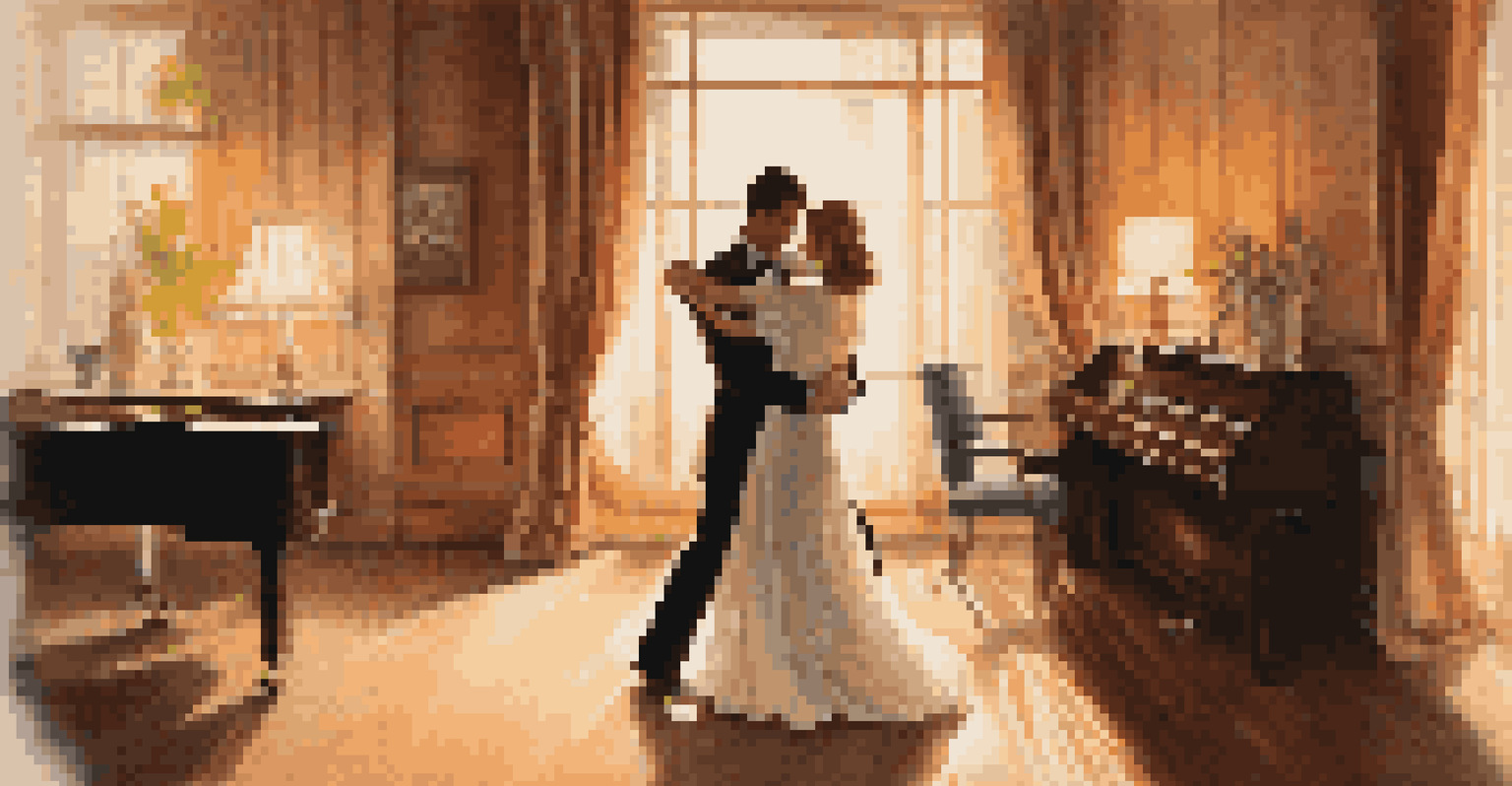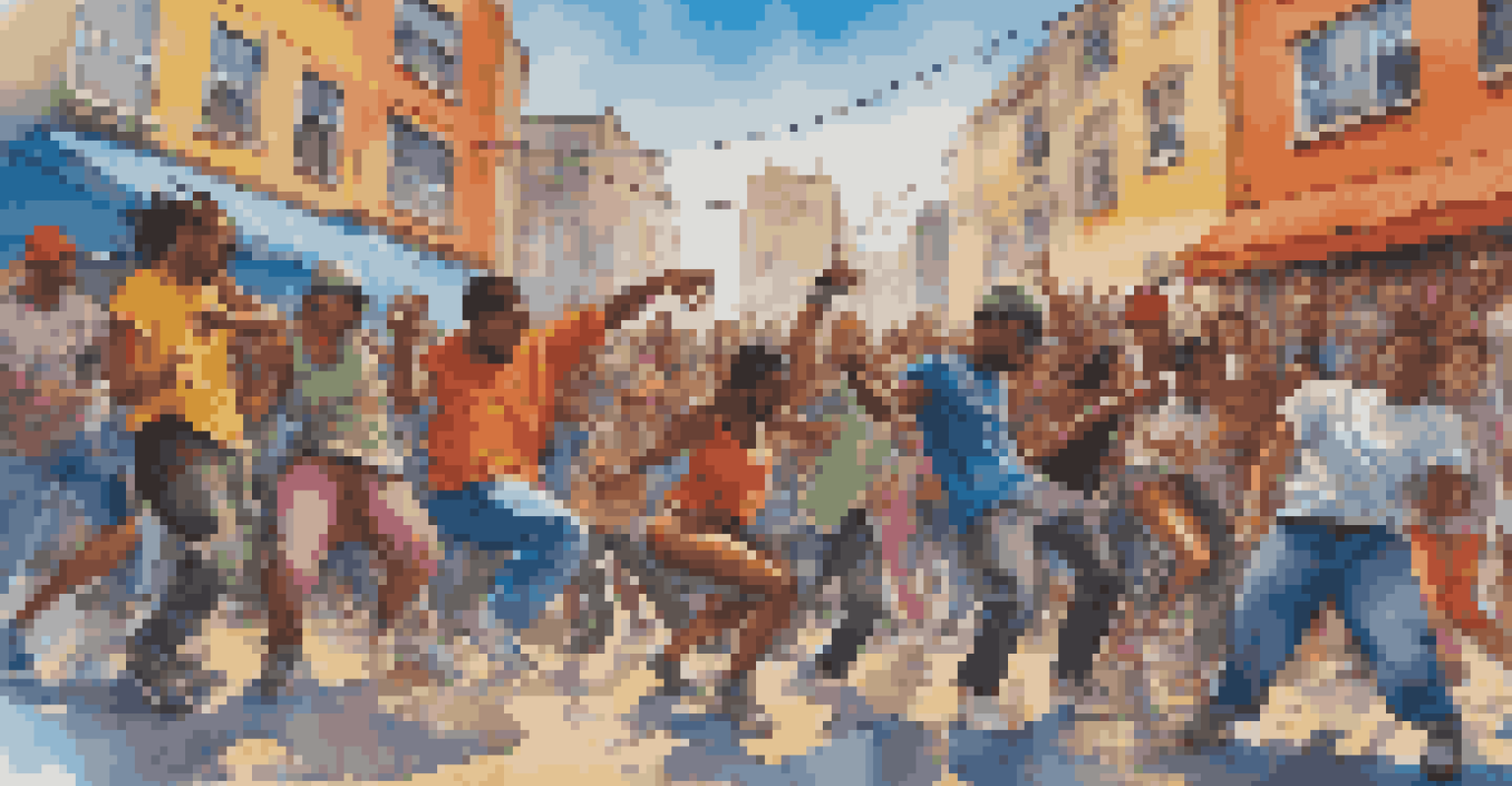The Intersection of Music and Dance in Film: A Comprehensive Study

The Historical Roots of Music and Dance in Film
The relationship between music and dance in film dates back to the early days of cinema, where silent films relied heavily on live orchestras to evoke emotions. This synergy laid the groundwork for the integration of sound and movement, creating a rich storytelling experience. As films evolved, the introduction of synchronized sound allowed for more complex interactions between music and dance, leading to iconic moments that defined genres.
Music is like a dream. One that I cannot hear.
For instance, early musicals like 'The Jazz Singer' showcased how vocal performances could be paired with choreographed dance sequences, bringing narratives to life in a way that captivated audiences. This historical progression illustrates how filmmakers began to harness the power of music and dance as complementary art forms, enhancing the viewer's emotional journey.
Furthermore, as technology advanced, so did the creativity behind these performances. The advent of color films and improved sound quality opened new avenues for choreographers and composers, allowing for more vibrant and innovative expressions of storytelling, as seen in classics like 'Singin' in the Rain' and 'West Side Story.'
The Role of Music in Enhancing Dance Performances
Music plays a crucial role in shaping the rhythm and emotional tone of dance sequences in film. It acts as a guiding force, helping dancers synchronize their movements while conveying the story's mood. For example, a lively upbeat score can energize a dance number, while a slower, melancholic piece can evoke feelings of introspection and sorrow.

The collaboration between composers and choreographers is essential in this process. They work together to create a harmonious blend of sound and movement, ensuring that each dance sequence feels organic and impactful. This partnership can lead to unforgettable moments, such as the mesmerizing dance choreography in 'La La Land,' where the music seamlessly enhances the story's romantic undertones.
Music and Dance: A Cinematic Duo
The integration of music and dance in film enhances storytelling, creating emotional connections and memorable moments.
Moreover, music can also dictate the style of dance portrayed on screen. Different genres of music inspire various dance forms, from the elegant waltzes of classic films to the dynamic hip-hop routines in contemporary blockbusters. This interplay creates a unique visual and auditory experience that resonates with audiences.
Choreography: The Art of Dance in Cinema
Choreography is the backbone of dance in film, transforming music into a visual spectacle. Choreographers carefully craft movements that not only align with the rhythm and mood of the music but also enhance the narrative of the film. Through innovative choreography, they bring characters and stories to life, allowing viewers to connect on a deeper level.
Dance is the hidden language of the soul.
Take the iconic dance scene in 'Dirty Dancing,' for instance. The choreography not only showcases the chemistry between the characters but also tells a story of growth and liberation, all set to a memorable soundtrack. Such masterful choreography elevates the film beyond mere entertainment, creating lasting emotional impressions.
Additionally, choreographers often draw inspiration from diverse dance styles, incorporating elements from ballet, jazz, hip-hop, and more. This blend of styles can create dynamic visual performances that captivate audiences, as seen in films like 'Step Up' series, where various dance forms converge to tell compelling stories.
Cultural Influences on Music and Dance in Film
Film is a powerful medium for showcasing cultural diversity, and music and dance play pivotal roles in representing different traditions. From Bollywood musicals to Latin dance films, the intersection of these art forms celebrates cultural heritage and stories. This representation not only entertains but educates audiences about various customs and practices.
For example, Disney's 'Coco' beautifully highlights Mexican culture through its music and dance, enriching the narrative while honoring traditions. The film's vibrant visuals and catchy songs resonate with audiences, illustrating how cultural elements can inspire and connect people across generations.
Cultural Diversity Through Art Forms
Film serves as a platform for showcasing cultural diversity, with music and dance representing various traditions and stories.
Moreover, as filmmakers explore global influences, they often blend styles to create unique cinematic experiences. This fusion can lead to innovative storytelling, as seen in films like 'Black Panther,' where traditional African music and dance are incorporated into a superhero narrative, bringing authenticity and depth to the characters and their world.
The Emotional Impact of Music and Dance in Film
One of the most compelling aspects of combining music and dance in film is its ability to evoke strong emotions. The synergy between these elements can amplify feelings of joy, sadness, excitement, or nostalgia, enhancing the viewer's overall experience. For instance, the exhilarating dance scenes in 'Footloose' serve as a cathartic release for the characters and the audience alike, making them feel a sense of liberation.
Moreover, music often provides context for dance, guiding the audience's emotional response. A dramatic score paired with a heart-wrenching dance can leave a lasting impression, as seen in the heartbreaking ballet sequence in 'Black Swan.' This interplay allows filmmakers to manipulate emotions, creating powerful moments that resonate long after the credits roll.
These emotional connections can also foster a sense of nostalgia, as music and dance often remind audiences of specific times or experiences in their lives. The iconic dance scenes in films like 'Grease' or 'Mamma Mia!' transport viewers back to their own memories, reinforcing the timeless power of music and dance in storytelling.
The Evolution of Music and Dance Genres in Film
As the film industry evolves, so do the genres of music and dance that accompany it. From the classic musicals of the mid-20th century to today's diverse offerings, filmmakers are continuously experimenting with styles and formats. This evolution reflects changing cultural trends and audience preferences, leading to innovative storytelling techniques.
For example, the rise of hip-hop culture has significantly influenced contemporary dance films, with movies like 'Step Up' and 'Honey' showcasing street dance styles that resonate with younger audiences. These films not only highlight the importance of dance but also celebrate the artistry and skill involved in these modern forms, pushing the boundaries of traditional choreography.
Future of Film: Innovation Awaits
Advancements in technology and global influences promise exciting transformations in how music and dance are integrated into film.
Additionally, the fusion of genres can create exciting new cinematic experiences. Films that blend elements of drama, romance, and dance, like 'A Star is Born,' showcase how music and dance can transcend genre boundaries, appealing to a broader audience while telling compelling stories.
Future Trends in Music and Dance in Film
Looking ahead, the intersection of music and dance in film is poised for exciting transformations. With advancements in technology, filmmakers are exploring new ways to integrate these elements, such as virtual reality and interactive experiences. This innovative approach could redefine how audiences engage with music and dance in films, creating immersive experiences that were previously unimaginable.
Moreover, as global connectivity increases, filmmakers are likely to draw inspiration from an even wider array of cultural influences. This trend will not only enrich the storytelling landscape but also promote inclusivity and representation in cinema. We may see more cross-cultural collaborations, leading to films that celebrate and blend diverse music and dance traditions.

Ultimately, the future of music and dance in film holds immense potential for creativity and innovation. As filmmakers continue to explore new techniques and styles, audiences can look forward to captivating performances that push the boundaries of storytelling, ensuring that the magic of music and dance remains an integral part of the cinematic experience.